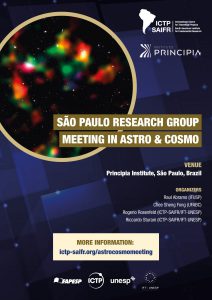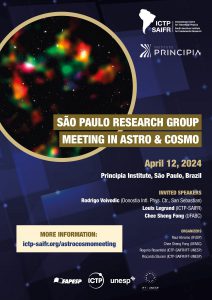São Paulo Research Group meetings in Astro & Cosmo

Next meeting: June 13, 2025
São Paulo, Brazil
Venue: Instituto Principia
Zoom id:
Password:
Home
If you want to receive mailings about the meetings, click HERE.
Organizers:
- Raul Abramo (IFUSP)
- Chee Sheng Fong (UFABC)
- Rogério Rosenfeld (IFT-UNESP)
- Riccardo Sturani (IFT-UNESP)
Announcement:
Invited Speakers June 13, 2025
10:00 Ricardo Medina (UFEI): Determining self-force corrections to the equation of the separatrix of a Schwarzschild black hole
Abstract: The separatrix is the 2-dimensional curve, well known in General Relativity textbooks. It consists of a curve in the (b_c, v) plane or in the (E, j_c) plane, where b, v, E and j are respectively the impact parameter, the velocity, the dimensionless Energy and the dimensionless angular momentum of a probe particle which is subject to the gravitational field of a black hole (which, for simplicity, here we consider to be a Schwarzschild one). For a given v and b > b_c, the probe is only scattered by the black hole and it escapes to infinity but for b < b_c the probe is captured by the black hole. The situation that we consider in this talk is the (more realistic) one of a “probe” with non negligible mass, which can indeed be another black hole since the “capture case” is the one that leads to the gravitational waves that have been directly detected on Earth since 2015. Numerical results exist in the literature for this problem but in this talk we are going to expand on the analytic approach for it. We will mention the limitations and benefits of both approaches.
11:15 Walter Riquelme (IFT-UNESP): Imprints of Large-Scale Structures in the Anisotropies of the Cosmological Gravitational Wave Background
Abstract: In this talk, I will present recent results on the cross-correlation between the anisotropies of the cosmological gravitational wave background (CGWB) and the galaxy density contrast [2505.15899]. I will review the current state of the art and highlight the role of this cross-correlation as a tool to distinguish between different origins of the stochastic gravitational wave background. I will discuss the detection prospects of the CGWB-LSS cross-correlation signal, considering the impact of cosmic variance and the sensitivity of upcoming large-scale structure and gravitational wave surveys. Finally, I will show that, by considering a CGWB sourced by scalar-induced gravitational waves and including a scale-dependent galaxy bias, this cross-correlation could be used to measure local primordial non-Gaussianity.
14:00 Gustavo Figueiredo Severiano Alves (IF-USP): Chasing Serendipity: Tackling Transient Sources with Neutrino Telescopes
Abstract: The discovery of ultra-high-energy neutrinos by IceCube marked the beginning of neutrino astronomy. Yet, the origin and production mechanisms of these neutrinos remain open questions. With the recent observation of the highest-energy neutrino event to date by the KM3NeT collaboration, transient sources—astrophysical objects that emit particles in brief, localized bursts—have emerged as promising candidates. In this work, we revisit the identification of such sources in IceCube and future neutrino telescopes, focusing on how both the timing and sky localization of the source affect the detection sensitivity. We highlight the crucial role of the source’s right ascension in determining the effective area of detectors not located at the poles, such as KM3NeT, and present a framework to consistently account for this dependence. As a case study, we investigate evaporating primordial black holes (PBHs) as transient neutrino sources, showing that the detection prospects and localization accuracy are strongly influenced by the PBH’s position in the sky. Our results emphasize the complementarity between neutrino and gamma-ray observatories and showcase the potential of a global network of neutrino detectors to identify and localize transient events that might be missed by traditional photon-based instruments.
Previous Meetings
- 10:00 Pedro Bittar (USP): Baryogenesis just around the corner: Generating the matter asymmetry at or below the weak scale – Video
- 11:15 Rodrigo Voivodic (Donostia Int. Physics Cent. San Sebastian & IFT-UNESP): Likelihoods – Video
- 14:00 Gustavo Henrique dos Santos (UFABC): ACT Constraints on Low Scale Inflation and a Mechanism for Vector Dark Matter Production – Video
-
- 10:00 Parth Bambhaniya (USP): Are We Sure It’s a Supermassive Black Hole at the Heart of Our Galaxy? – Video
- 11:15 Natalia Villa Rodrigues (USP) : Modeling halo bias with neural networks – Video
- 14:00 Vitor Sampaio (UNICID): Disks and Spheroids across cosmic time: Morphological and Star Formation Evolution of Galaxies from z = 2.4 to z = 0.2 – Video
March 14, 2025
-
10:00 Jorge Luiz Meléndez Moreno (IAG, USP): Solar Twins and their implications for Planets, Stars and the Galaxy – Video
Participants List: Here
2024
November 8, 2024
- 10:00 Abdias Aires (IFT-UNESP): Mitigation of nonlinear galaxy bias with theoretical-error likelihood – Video
- 11:00 Giorgio Torrieri (Unicamp): Non-local effective field theory in general relativity – Video
- 14:00 Daniel Lopez-Cano (IF-USP): Machine Learning Applications in Cosmology: Past, Present, and Future – Video
Participants List: Here
October 11, 2024
- 10:00 Walter Riquelme (IFT/UNESP): Unveiling the initial conditions of the universe with galaxy surveys – Video
- 11:00 Yago Porto (UFABC): Flavor Matters, but Matter Flavors: Matter Effects on Flavor Composition of Astrophysical Neutrinos – Video
- 14:00 Lilianne Nakazono (USP): Searching for quasars in the era of large multi-wavelength datasets – Video
Participants List: Here
September 13, 2024
- 10:00 – João Victor Silva (IFT UNESP): Dynamical Dark Energy and Massive Neutrinos in Light of DESI 2024 BAO – Video
- 11:00 – Lia Doubrawa (IAG USP): Galaxy clusters in photometric surveys: detection and analysis – Video
Participants List: Here
August 16, 2024
- 10:00 – Edivaldo Moura Santos (USP): The ultra-high energy cosmic ray sky – Video
- 11:00 – João Vitor Dinarte Ferri (USP): A cosmic standard ruler from the cross-correlations of galaxies and dark sirens – Video
- 14:00 – Natali de Santi (USP São Carlos): Cosmology with graph neural networks – Video
Participants List: Here
June 14, 2024
- 10:00 – Nickolas de Aguiar Alves (UFABC): Don’t forget about the memory
- 11:00 – Reinaldo de Carvalho (UNICID): Studies on Galaxy Morphology: Diving into the Primordial Era
- 14:00 – Isabela Santiago de Matos (IFT-UNESP): Cosmological tests with bright and dark standard sirens
Participants List: Here
May 10, 2024
- 10:00 – Lucas Gabriel Silva (IAG USP): Galaxy cluster mass estimation using the splashback radius
- 11:00 – Adriana Valio (Mackenzie): Exoplanetas: atmosferas e habitabilidade
- 14:00 – Carol Guandalin (Institute for Astronomy (IfA), University of Edinburgh): I see bispectrum everywhere
April 12, 2024
- 10:00 – Rodrigo Voivodic (Donostia Intl. Phys. Ctr., San Sebastian): The Hybrid Lagrangian Perturbation Theory
- 11:00 – Louis Legrand (ICTP-SAIFR): Next generation galaxy and CMB surveys: optimal estimators and cross-correlations
- 14:00 – Chee Sheng Fong (UFABC): How much baryon asymmetry and dark matter can be generated from primordial black holes?
Announcement:
Photos
Additional Information
How to reach the Principia Institute: The meeting will be held in the first-floor auditorium of the Science Center at Principia Institute located at Rua Pamplona, 145 near the Trianon-Masp metro station.


